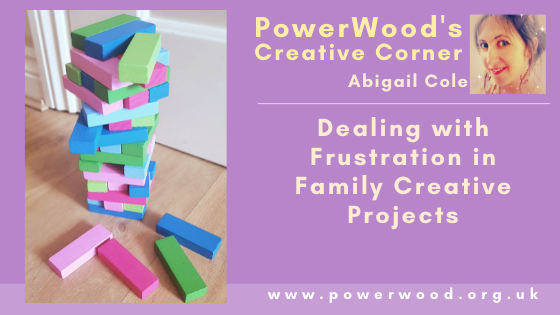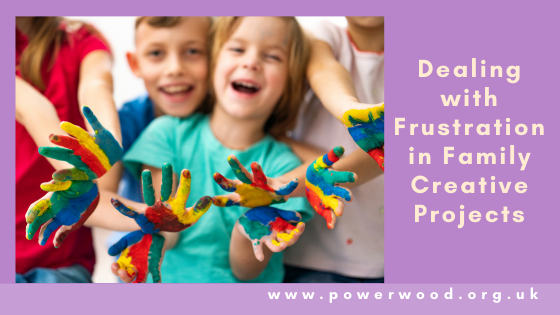
A lot of the time when I am writing about simple family creativity with such enthusiasm and the idea of easeful family creativity in mind, I am often focusing on the fun and joyful aspects of getting crafty together at home as well as ways to make it feel doable and approachable. There is definitely much fun to be had, and there are lots of little things that can make creativity in the home easier to approach – tips for mess-free crafts, ideas for setting up a crafting space, steps and tutorials for simple crafts to try… but even with all of this in place, there can still be times when frustration – in this blog Simone de Hoogh explains the value of those uncomfortable feelings – is running the show and even carrying out the simplest craft doesn’t feel so easy.
I have experienced this both at home, with my own children during family activities, and occasionally in groups I have led over the years. I also bump up against frustration in my own creative work from time to time too. I think it’s a very natural part of any creative process, but I can also see how it can become a bit of a barrier and obstacle to enjoying, or even starting, creative pursuits.
There are a few things that I have learned over the years when it comes to recognising and even valuing the element of frustration when it arises. Last year, in this blog post I explored an example of how we turned a spilled paint incident into an opportunity for learning to embrace our mistakes, and ultimately growth. Getting past the frustrating bits in any craft most definitely offers an opportunity for growth, especially since we usually have something to show for all our energy and effort if we can see a craft through to the end – we can hopefully feel proud that we created something from nothing, especially if we managed to not let our uncomfortable feelings keep us away from doing it. However, as parents, teachers, creative guides to our children, it can sometimes be a challenge to witness their frustration and discomfort as they struggle to get to grips with the fine skills in any given craft.
Being ready for some frustration to arise
One of the reasons that I love simple creativity so much is because it brings me back to the basics over and over and reminds me that even within seemingly simple tasks, there are still core skills at play. Often these are skills that younger children are yet to master, and even older children are still practicing – creative projects give the perfect opportunity to practice. Given that children are still actively learning and sometimes trying to get to grips with a new skill from scratch, just like learning to roller-skate or ride a bike, there will inevitably be moments of frustration. I find that if I begin a craft project with the expectation that my child might find some bits tricky and get frustrated, I am more able to stay calm myself, and help them find a way through.
This doesn’t mean that I expect less of them or what they can do, or encourage them less, it’s more that I know the opposite to be true; if I expect too much too soon (for example when I get over-enthusiastic about a project that I hope everyone will love!) and frustration arises, we can all end up frustrated and impatient.
There can be plenty of different reasons for frustration. Asynchronous development might be a factor, for example if a child really has a beautiful and detailed visualisation in their minds-eye of the thing they want to create, but their physical/motor skills simply haven’t developed yet in such a way as to enable them to create the thing they can visualise. This can be very frustrating and often settling for a less accomplished version is just too disappointing. Perfectionism can play a part in this as well, along with a fixed mindset/expectation that the outcome of the project has to be perfect or it’s not worth it.
At times like this it can be helpful just to gently remind children that their body/motor skills might not have caught up with their imagination yet but that the gap will close as they grow.

Offer a balance of activities and quiet compassion
Another approach I find quite effective if this is at dynamic play, is to start with crafts that are ‘open-ended’ – that don’t begin with a prescribed end result, for example construction crafts – like junk modelling with nuts & bolts and a hot glue gun – this is similar to playing free-form with lego where the creation/construction unfolds along the way. This isn’t to bypass the original frustration – of course it is still disappointing not to be able to create the thing you visualise, it is more to build up a positive experience of creative activities – as well as allowing time for motor skills to develop through practice and in a less pressured way – so that it’s possible to re-visit the frustrating craft in time (if you choose!), and once skills have developed it should feel easier.
Over time, as skills develop, you can begin to offer a balance of projects – for example, free-flowing open-ended projects that have an undefined goal, with some more goal-orientated projects occasionally or, simple activities to practice core skills, with more complicated projects as time goes on. You could also consider the balance of purely child-led vs gently guided projects (if for example you have a child who tends to be quite ambitious in their ideas and struggles with making things go exactly the way they visualise). This is so that you can build up a bit of a bank of positive creative experiences, without shying away from attempting more challenging things in the mix too. Hopefully, after a few positive creative experiences that felt quite easy and went well – you will be in ‘energy credit’ for attempting the more tricky ones and dealing with any frustration that may follow.
Sometimes, setting a clear boundary around a task can be helpful. For example, if you are making an entire diorama of your child’s bedroom – you could say “today we are just going to work on the bed, it’s a bit fiddly and we’ll give ourselves plenty of time just to get that done”. Or, set aside a regular, repeating slot in which to carry out craft activities. This can feel a bit counter-intuitive since creativity is often associated with spontaneity. It can be fun to follow creative impulses as they arise, and it can seem like a shame to interrupt a child if they are in self-initiated creative flow – however having a regular slot in which to create can have its benefits too. It can create a helpful sense of stability, reliability, which in turn fosters a sense of safety and in turn, freedom to explore.
Having a regular slot, or setting a few gentle time/task limits can also help with having the energy available to calmly hold the creative space. It can mean having the chance to make sure our own baseline, your energy level and emotional resilience, is good, allowing us to remain quietly compassionate and less likely to react too much or become over-involved when frustration arises. Hopefully our quiet compassion can give the message that it’s normal to feel frustrated occasionally, and safe to continue playing and experimenting.
Our Kind Voice
When children are declaring “it’s not good enough” and they don’t like what they have made, and “it’s rubbish” because it didn’t go how they expected, as they often do, I find that telling them that “well I really like it and think it is wonderful”, doesn’t really help. In my experience, it rarely gets them to change their own mind on what they think about their own work. It also runs the risk of causing them to feel unheard (and more frustrated!). Sometimes it is the case that there really aren’t any words, and the disappointment just needs to be felt. At these times extra words might add fuel to the fire, and a kind smile or an empathic gesture (e.g. a cuddle if appropriate), is really enough. At other times, if it seems OK to say something, I will try to focus on the effort put in, acknowledge the frustration and disappointment, and if I am going to say that I really like it – try to frame it with “the thing that I really like about what you have made is…” and focus on one or two small details rather than the whole – that way, I have thought about it, and will hopefully feel more truthful and realistic. I have yet to see a child’s creation that I can’t appreciate something about!
In her blog Our Kind Voice, Simone de Hoogh explains more about the words we choose when speaking to our children and gives a useful guide about how to cultivate a ‘kind voice’ to help us ensure that “as parents… whatever we add to the subconscious of our children is as positive and constructive as can be”.
“Do something logical instead…”And of course, even if you try all these tips, there will still be times when the creative process is just very frustrating, and that’s OK too. It’s ok just to let that be a part of the experience and perhaps learning the value of uncomfortable feelings as described by Simone de Hoogh and how to navigate them will be useful. Overall, it can help with learning to solve problems as they arise (both in creative projects and in life), and to be able to handle disappointment from time to time too. I have found, now that my children are a bit older that – yes they will bump up against a bit of frustration from time to time, but they will now more frequently stop, pause, think of a solution or a new plan and glide over the bump in the road with a bit more ease than before. In fact, my son just gave me the advice that when feeling frustrated with something creative, a good thing to do is take a break and do something logical instead; he’s found his own way to break out of a creative block. I hope that this will be something that you can experience in your family too, and that those frustrating moments, rather than being a barrier to creativity, can become one of the gifts of having plenty of crafty-days together at home, if you choose.
© 2021 Abigail Cole, all posts by Abigail Cole on the PowerWood website and you can find more creative ideas at Abigail’s website Forgetful Fairy Art Studio.
Help us to continue support to all neurodiverse families and individuals
PowerWood offers to neurodiverse families understanding, simple tools and strategies that enable us to support ourselves and our children through emotional overwhelm. If you enjoy reading the articles please support PowerWood making all information available to all by becoming a PowerWood Community FreeBee or Friend member. Thank YOU!

